Unit 1 Face Values Developing ideas 课件(共20张PPT)-外研版(2019)选择性必修第三册
文档属性
| 名称 | Unit 1 Face Values Developing ideas 课件(共20张PPT)-外研版(2019)选择性必修第三册 | 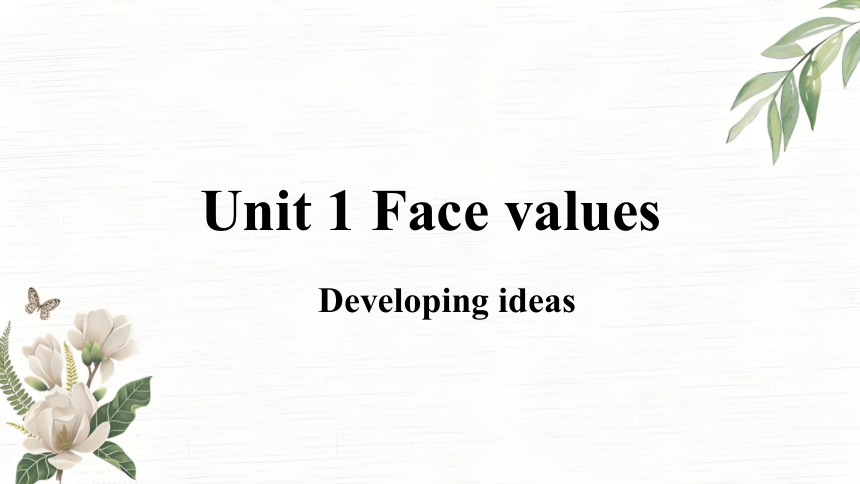 | |
| 格式 | pptx | ||
| 文件大小 | 886.8KB | ||
| 资源类型 | 教案 | ||
| 版本资源 | 外研版(2019) | ||
| 科目 | 英语 | ||
| 更新时间 | 2025-07-28 13:15:43 | ||
图片预览

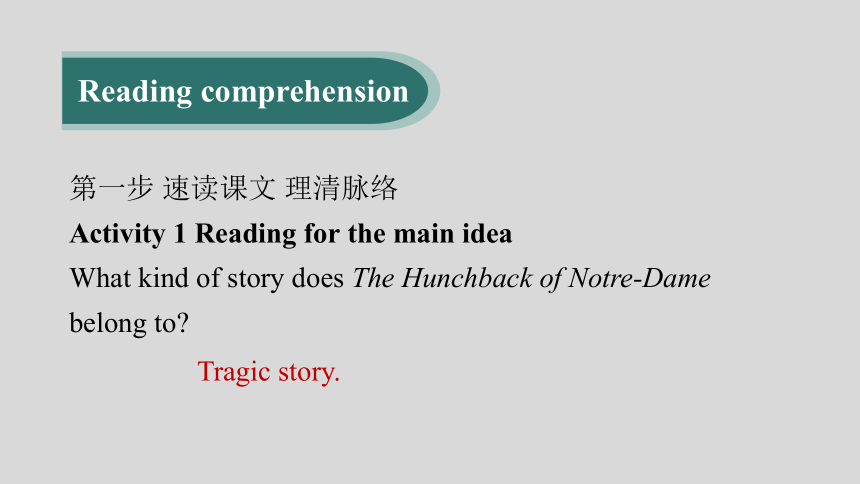
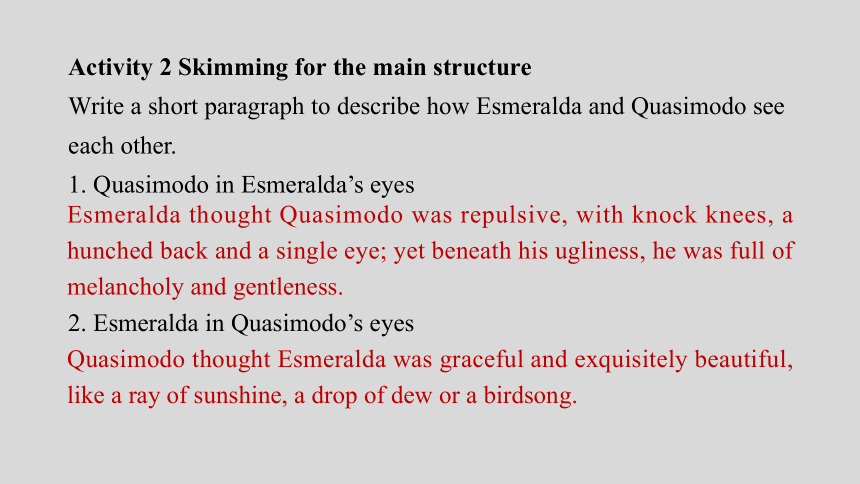
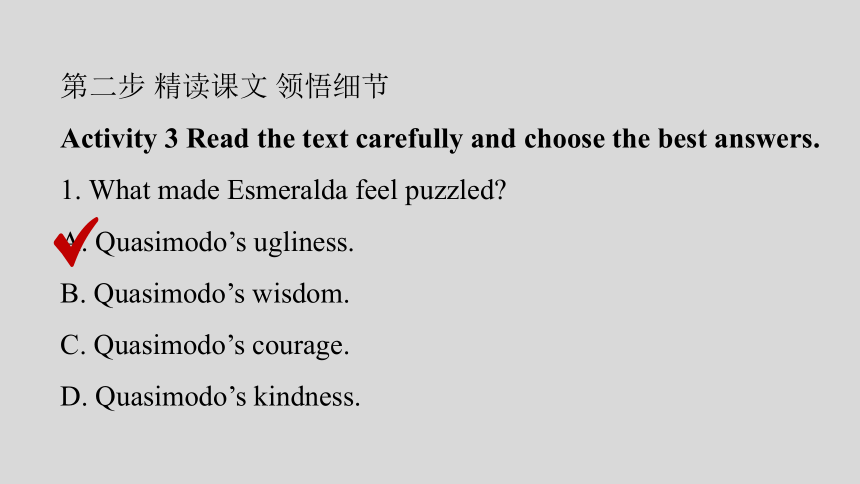
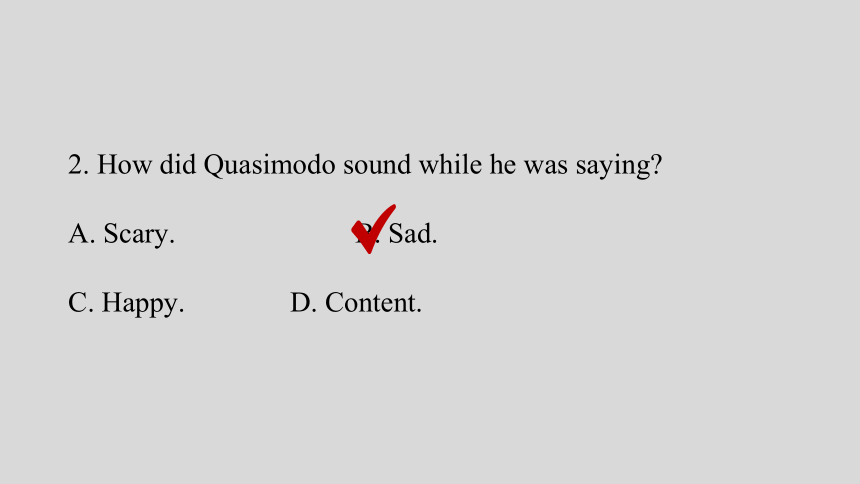
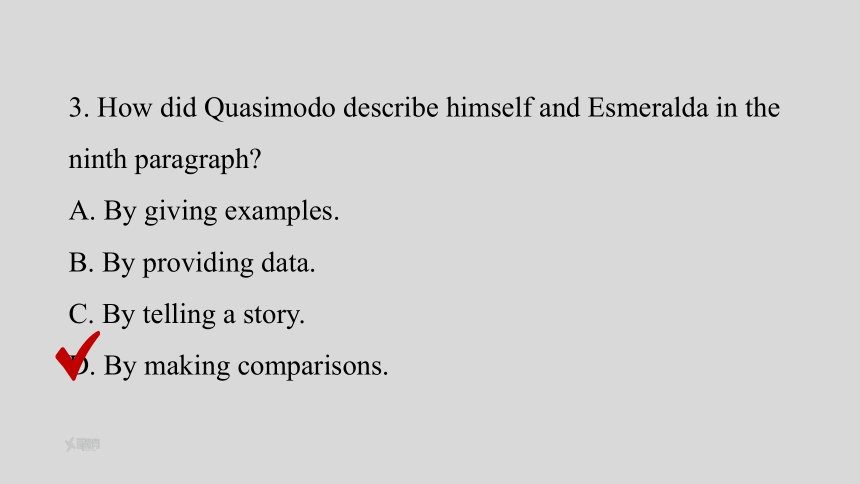
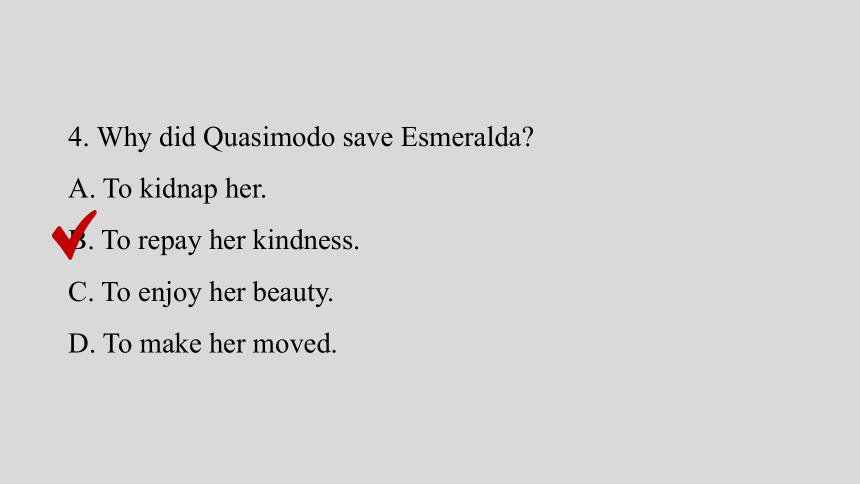
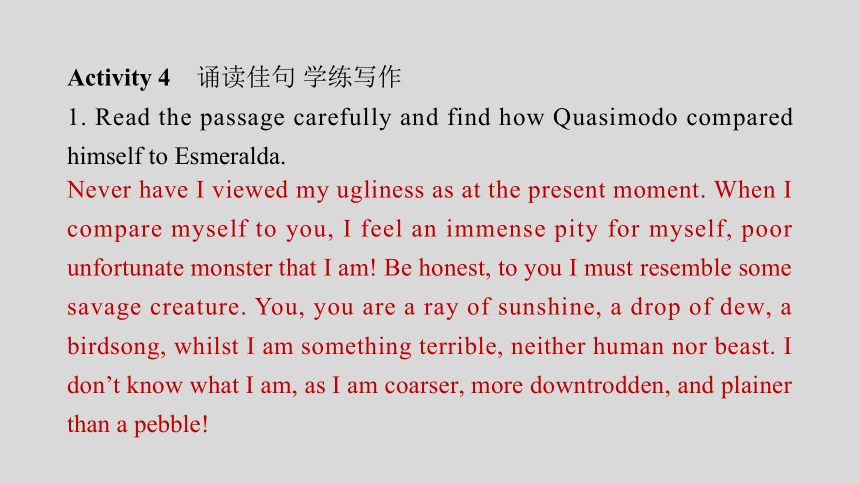
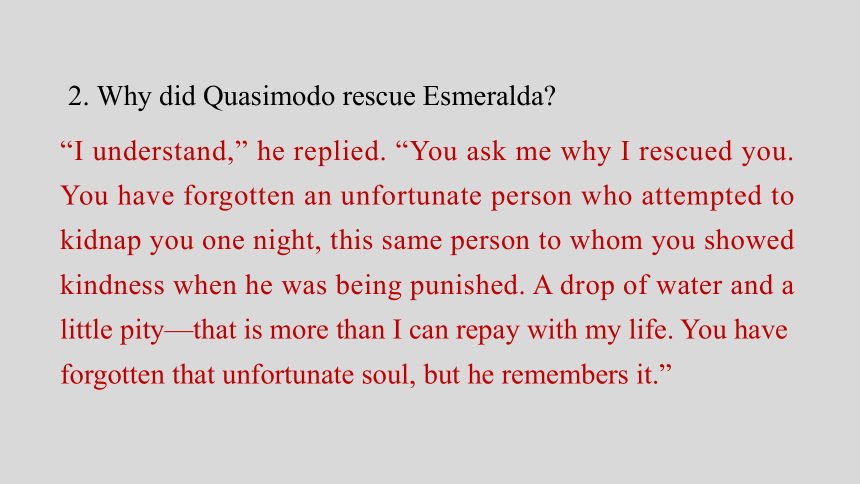
文档简介
(共20张PPT)
Unit 1 Face values
Developing ideas
第一步 速读课文 理清脉络
Activity 1 Reading for the main idea
What kind of story does The Hunchback of Notre-Dame belong to
Tragic story.
Reading comprehension
Activity 2 Skimming for the main structure
Write a short paragraph to describe how Esmeralda and Quasimodo see each other.
1. Quasimodo in Esmeralda’s eyes
2. Esmeralda in Quasimodo’s eyes
Esmeralda thought Quasimodo was repulsive, with knock knees, a hunched back and a single eye; yet beneath his ugliness, he was full of melancholy and gentleness.
Quasimodo thought Esmeralda was graceful and exquisitely beautiful, like a ray of sunshine, a drop of dew or a birdsong.
第二步 精读课文 领悟细节
Activity 3 Read the text carefully and choose the best answers.
1. What made Esmeralda feel puzzled
A. Quasimodo’s ugliness.
B. Quasimodo’s wisdom.
C. Quasimodo’s courage.
D. Quasimodo’s kindness.
2. How did Quasimodo sound while he was saying
A. Scary. B. Sad.
C. Happy. D. Content.
3. How did Quasimodo describe himself and Esmeralda in the
ninth paragraph
A. By giving examples.
B. By providing data.
C. By telling a story.
D. By making comparisons.
4. Why did Quasimodo save Esmeralda
A. To kidnap her.
B. To repay her kindness.
C. To enjoy her beauty.
D. To make her moved.
Activity 4 诵读佳句 学练写作
1. Read the passage carefully and find how Quasimodo compared himself to Esmeralda.
Never have I viewed my ugliness as at the present moment. When I compare myself to you, I feel an immense pity for myself, poor unfortunate monster that I am! Be honest, to you I must resemble some savage creature. You, you are a ray of sunshine, a drop of dew, a birdsong, whilst I am something terrible, neither human nor beast. I don’t know what I am, as I am coarser, more downtrodden, and plainer than a pebble!
2. Why did Quasimodo rescue Esmeralda
“I understand,” he replied. “You ask me why I rescued you. You have forgotten an unfortunate person who attempted to kidnap you one night, this same person to whom you showed kindness when he was being punished. A drop of water and a little pity—that is more than I can repay with my life. You have forgotten that unfortunate soul, but he remembers it.”
重点单词
1. defect n. 缺点,缺陷,毛病
2. accent n. 口音
3. resemble v. 像;与……类似,与……相似
4. heartbreaking adj. 令人悲伤的
5. repay v. 报答
6. motive n. (尤指隐藏的)动机,原因,目的
7. kidnap v. 绑架;劫持
8. torture v. 拷打,拷问
Key points
9. execution n. (尤指依法的)处死
10. predicament n. 尴尬的处境
11. repulsive adj. 令人厌恶的
12. hunched adj. 弓身的,弓背的
13. wretch n. 可怜的人
14. exclaim v. (因惊讶、愤怒或兴奋而)呼喊,惊叫
15. heartfelt adj. 衷心的,诚挚的
passion n. 怜悯;同情
17. exquisite adj. 精美的,精致的
18. utter v. (尤指吃力地)发出(声音)
19. syllable n. 音节
20. immense adj. 巨大的
21. monster n. 怪物
22. savage adj. 野蛮的
23. intently adv. 专心地;一心一意地
24. profound adj. (感情)强烈的,深切的
重点短语
1. out of mercy 出于怜悯
2. be sentenced to death 被判处死刑
3. adjust to 适应
4. attempt to do sth. 试图做某事
5. rescue…from… 把……从……中营救出来
6. as long as 只要
7. beyond one’s comprehension 某人无法理解
8. in any case 无论如何
高频词汇
1. mercy
(1) mercy n. 仁慈;宽恕;怜悯
show mercy to/have mercy on sb. 怜悯某人
at the mercy of sb.=at one’s mercy 任某人摆布,受某人控制
It’s a mercy that… ……真是万幸。
without mercy 毫不留情
(2) merciful adj. 仁慈的,慈悲的
be merciful to/towards sb. 对某人仁慈
2. sentence
sentence n.判决 v. 宣判;判刑
serve one’s sentence 服刑
announce sentence on sb. 宣布对某人的判决
sentence sb. to death 判某人死刑
sentence sb. to…year(s) in prison 判处某人……年徒刑
3. comprehension
(1) reading comprehension 阅读理解
beyond/above one’s comprehension 难理解的;不可理解的
have no comprehension of 不理解
be low of comprehension 理解力迟钝的
(2) comprehend v. 理解,领悟
4. attempt
(1) attempt v. 尝试;企图
attempt sth. 尝试某事
(2) attempt n. 努力;尝试;企图
make an attempt to do sth./at doing sth. 努力做某事;试图做某事
in an attempt to do sth. 试图做某事
重点句式
1. 过去分词(短语)作状语
Published in 1831, The Hunchback of Notre-Dame tells a tragic story of events in Paris.
(1)过去分词(短语)作状语表示时间、原因、让步、条件、方式或伴随等。
(2)过去分词(短语)作状语时,其逻辑主语为主句的主语,此时应注意人称一致。
(3)过去分词(短语)作状语可改为状语从句,但作方式或伴随状语时不能改为状语从句,但可以改写成并列句。
(4)过去分词(短语)作状语的位置:可放在主句前,后面有逗号与主句隔开;也可放在主句后面,前面有逗号与主句隔开。
2. 否定意义的词置于句首的部分倒装
Never have I viewed my ugliness as at the present moment.
(1)否定副词never置于句首,句子需用部分倒装结构,即把助动词、情态动词或系动词be提到主语之前。
(2)常用否定副词和含有否定意义的介词(短语)还有 neither, seldom, hardly, scarcely, nor, at no time, by no means, in no case, on no condition等。
THANKS
Unit 1 Face values
Developing ideas
第一步 速读课文 理清脉络
Activity 1 Reading for the main idea
What kind of story does The Hunchback of Notre-Dame belong to
Tragic story.
Reading comprehension
Activity 2 Skimming for the main structure
Write a short paragraph to describe how Esmeralda and Quasimodo see each other.
1. Quasimodo in Esmeralda’s eyes
2. Esmeralda in Quasimodo’s eyes
Esmeralda thought Quasimodo was repulsive, with knock knees, a hunched back and a single eye; yet beneath his ugliness, he was full of melancholy and gentleness.
Quasimodo thought Esmeralda was graceful and exquisitely beautiful, like a ray of sunshine, a drop of dew or a birdsong.
第二步 精读课文 领悟细节
Activity 3 Read the text carefully and choose the best answers.
1. What made Esmeralda feel puzzled
A. Quasimodo’s ugliness.
B. Quasimodo’s wisdom.
C. Quasimodo’s courage.
D. Quasimodo’s kindness.
2. How did Quasimodo sound while he was saying
A. Scary. B. Sad.
C. Happy. D. Content.
3. How did Quasimodo describe himself and Esmeralda in the
ninth paragraph
A. By giving examples.
B. By providing data.
C. By telling a story.
D. By making comparisons.
4. Why did Quasimodo save Esmeralda
A. To kidnap her.
B. To repay her kindness.
C. To enjoy her beauty.
D. To make her moved.
Activity 4 诵读佳句 学练写作
1. Read the passage carefully and find how Quasimodo compared himself to Esmeralda.
Never have I viewed my ugliness as at the present moment. When I compare myself to you, I feel an immense pity for myself, poor unfortunate monster that I am! Be honest, to you I must resemble some savage creature. You, you are a ray of sunshine, a drop of dew, a birdsong, whilst I am something terrible, neither human nor beast. I don’t know what I am, as I am coarser, more downtrodden, and plainer than a pebble!
2. Why did Quasimodo rescue Esmeralda
“I understand,” he replied. “You ask me why I rescued you. You have forgotten an unfortunate person who attempted to kidnap you one night, this same person to whom you showed kindness when he was being punished. A drop of water and a little pity—that is more than I can repay with my life. You have forgotten that unfortunate soul, but he remembers it.”
重点单词
1. defect n. 缺点,缺陷,毛病
2. accent n. 口音
3. resemble v. 像;与……类似,与……相似
4. heartbreaking adj. 令人悲伤的
5. repay v. 报答
6. motive n. (尤指隐藏的)动机,原因,目的
7. kidnap v. 绑架;劫持
8. torture v. 拷打,拷问
Key points
9. execution n. (尤指依法的)处死
10. predicament n. 尴尬的处境
11. repulsive adj. 令人厌恶的
12. hunched adj. 弓身的,弓背的
13. wretch n. 可怜的人
14. exclaim v. (因惊讶、愤怒或兴奋而)呼喊,惊叫
15. heartfelt adj. 衷心的,诚挚的
passion n. 怜悯;同情
17. exquisite adj. 精美的,精致的
18. utter v. (尤指吃力地)发出(声音)
19. syllable n. 音节
20. immense adj. 巨大的
21. monster n. 怪物
22. savage adj. 野蛮的
23. intently adv. 专心地;一心一意地
24. profound adj. (感情)强烈的,深切的
重点短语
1. out of mercy 出于怜悯
2. be sentenced to death 被判处死刑
3. adjust to 适应
4. attempt to do sth. 试图做某事
5. rescue…from… 把……从……中营救出来
6. as long as 只要
7. beyond one’s comprehension 某人无法理解
8. in any case 无论如何
高频词汇
1. mercy
(1) mercy n. 仁慈;宽恕;怜悯
show mercy to/have mercy on sb. 怜悯某人
at the mercy of sb.=at one’s mercy 任某人摆布,受某人控制
It’s a mercy that… ……真是万幸。
without mercy 毫不留情
(2) merciful adj. 仁慈的,慈悲的
be merciful to/towards sb. 对某人仁慈
2. sentence
sentence n.判决 v. 宣判;判刑
serve one’s sentence 服刑
announce sentence on sb. 宣布对某人的判决
sentence sb. to death 判某人死刑
sentence sb. to…year(s) in prison 判处某人……年徒刑
3. comprehension
(1) reading comprehension 阅读理解
beyond/above one’s comprehension 难理解的;不可理解的
have no comprehension of 不理解
be low of comprehension 理解力迟钝的
(2) comprehend v. 理解,领悟
4. attempt
(1) attempt v. 尝试;企图
attempt sth. 尝试某事
(2) attempt n. 努力;尝试;企图
make an attempt to do sth./at doing sth. 努力做某事;试图做某事
in an attempt to do sth. 试图做某事
重点句式
1. 过去分词(短语)作状语
Published in 1831, The Hunchback of Notre-Dame tells a tragic story of events in Paris.
(1)过去分词(短语)作状语表示时间、原因、让步、条件、方式或伴随等。
(2)过去分词(短语)作状语时,其逻辑主语为主句的主语,此时应注意人称一致。
(3)过去分词(短语)作状语可改为状语从句,但作方式或伴随状语时不能改为状语从句,但可以改写成并列句。
(4)过去分词(短语)作状语的位置:可放在主句前,后面有逗号与主句隔开;也可放在主句后面,前面有逗号与主句隔开。
2. 否定意义的词置于句首的部分倒装
Never have I viewed my ugliness as at the present moment.
(1)否定副词never置于句首,句子需用部分倒装结构,即把助动词、情态动词或系动词be提到主语之前。
(2)常用否定副词和含有否定意义的介词(短语)还有 neither, seldom, hardly, scarcely, nor, at no time, by no means, in no case, on no condition等。
THANKS
